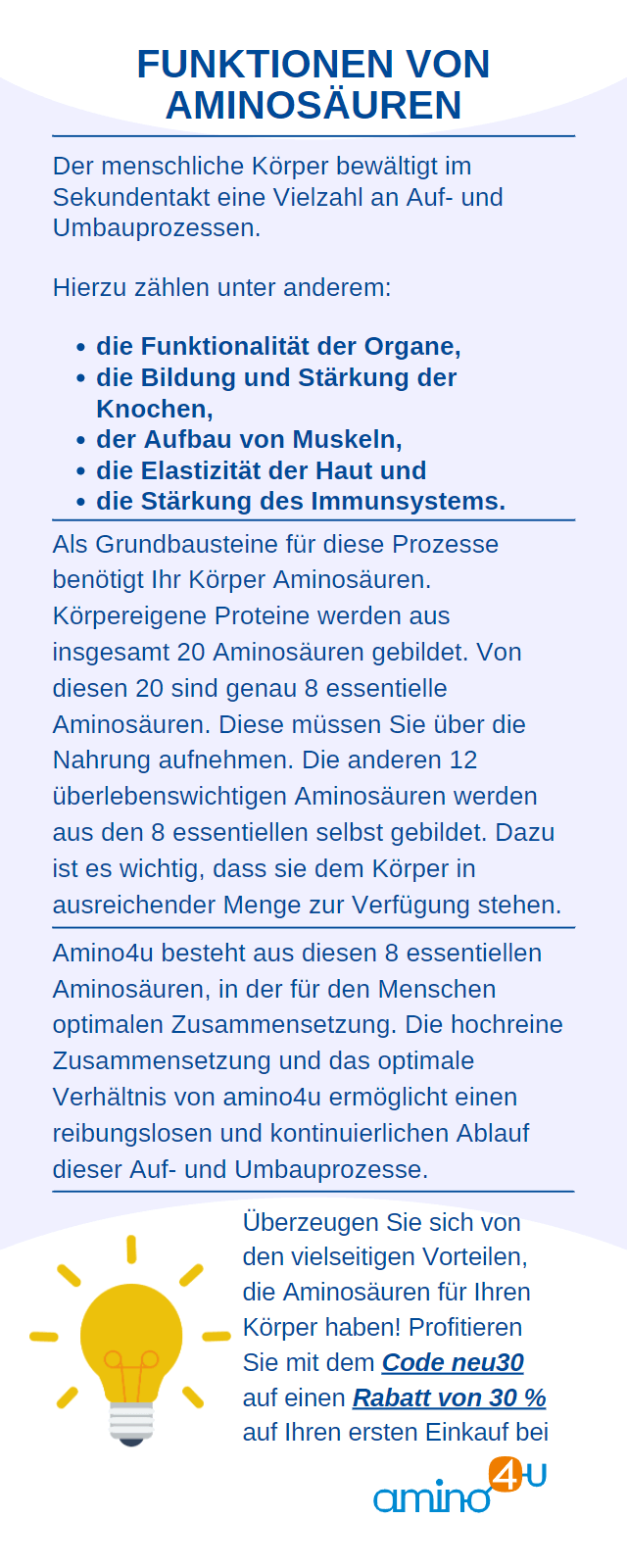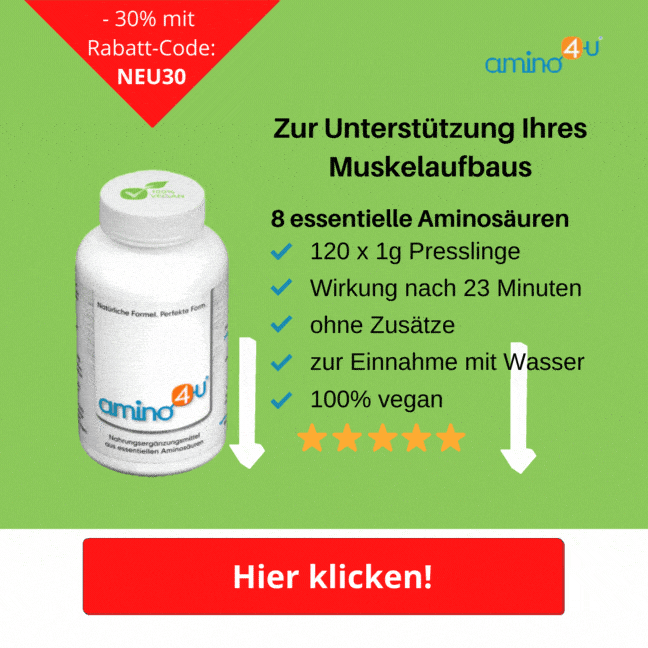Do you want to build muscle? Then it’s time to create the framework conditions. In addition to tailored training, sufficient regeneration phases and the right mindset, diet plays a key role.
In practice, however, it is repeatedly shown that many exercisers follow the wrong nutrition plan.
In order to understand how muscle substance can be built healthily, it is essential to look at food and how the individual components work together.
This article explains what the optimal diet for muscle growth looks like and can help you create a “ muscle building ” nutrition plan.

Step by step to building muscle
You shouldn't leave the food to chance - because success will most likely only come if you take every little detail into account.
Therefore, here you will find step-by-step instructions and information about the individual building blocks to build targeted muscle substance .
1st step: Calculating the energy balance
You can build muscle systematically if you have a calorie surplus. This means you eat more calories than you burn every day. You therefore exceed your total sales.
The total metabolic rate is a composite value of your basal metabolic rate and the performance metabolic rate. This refers to the calories that you need every day so that your body can do its job.
Also important is the metabolic rate, which is the calories you burn during all physical activities - not including sports.
You can roughly calculate your basal metabolic rate in calories using the following formula:
- Basal metabolic rate man : weight (in kg) x 24 (h)
- Basal metabolic rate woman : weight (in kg) x 24 (h) x 0.9
The performance turnover is very individual. What matters here is what your everyday life looks like and what activities you do. The PAL factor, the abbreviation for Physical Activity Level - is multiplied by the basal metabolic rate.
From this table you can choose the PAL factor for your most typical activity:
| activity | PAL factor |
| Sleep | 0.95 |
| Lying, sitting | 1.2 |
| Office job | 1.4 - 1.5 |
| sedentary activity with movement units | 1.6 - 1.7 |
| Standing professions | 1.8 - 1.9 |
| Heavy physical work and sports | 2.0 - 2.4 |
Now the number of calories calculated from the basal metabolic rate can be multiplied by the performance metabolic rate. A man who has a basal metabolic rate of 2000 calories and works an office job has the following total turnover :
2000 kcal 1.5 = 3000 kcal

Step 2: Building muscle only works with a calorie surplus
Muscles can build better if more calories are consumed than burned every day. This means you are eating more than your total intake. Remember that you should adjust your performance turnover accordingly.
For example, if you have calculated the PAL factor for a sedentary activity in the office, but regularly go to the gym and cycle to work, you should calculate the calorie consumption for these activities.
Then add the result to the total sales for the respective day. Otherwise, you may end up not having a calorie surplus on the days you exercise or are more active overall .
Then orientate yourself on the respective end result, although deviations of 50 kcal upwards or downwards are not tragic.
When you plan your meals, you exceed your total consumption and therefore have a positive calorie balance . Remember: you're not just building muscle , you're also building fat.
Opinions differ when it comes to the number of excess calories. Some guides recommend 300 to 500 calories. However, it would be better if you choose the golden mean and be 100 to 200 kcal above your total turnover.
This allows you to slowly gain weight and build up the mass step by step . Alternatively, use your body weight as a guide. If you are just starting to build up, you may gain 1.5% of your body weight each month.
If you are already good at training, the value should go down to 0.5-1.0%. As a professional in bodybuilding or kickboxing, you only eat 100 kcal per month above your total intake because your body is already used to training.
Speaking of training: In order to convert the excess calories into muscles, you must regularly do strength training with heavier weights - otherwise the extra energy cannot be converted into muscles, but into fat deposits.
Step 3: The correct distribution of macronutrients for strong muscles
Building healthy muscles works better if the type of food is tailored to the amount of calories. But what does healthy mean in this case? It is important that you pay attention to the correct distribution of the three macronutrients proteins, carbohydrates and fats .
If you want to build muscle , proteins are indispensable, but they do not play the same key role as they do with low-carb diets, as there is no risk of muscle loss.
carbohydrates
With too few carbohydrates in your diet, the project to build more muscles will be less likely to be successful. If the body has a deficit in carbohydrates, it first resorts to fat reserves and then to protein stores.
What is desired when losing weight does not work when it comes to muscle training . If the carbohydrate stores are empty over time, the opposite effect sets in and muscles are broken down. This can essentially make strength training pointless.
Carbohydrates stimulate the pancreas to secrete insulin. This can have an anabolic effect, meaning the muscles receive a growth stimulus .
But there are a few things to consider when choosing carbohydrates. Sugar and white flour products cause blood sugar levels to rise quickly. Therefore, choose foods with a low glycemic index .
This value indicates how quickly blood sugar levels rise after consumption.
Foods that contain good carbohydrates and have a low glycemic index include:
- potatoes
- Whole wheat pasta
- Brown rice
- bulgur
- oatmeal
- Chickpeas
- Pseudograins such as quinoa and amaranth
Vegetables also contain carbohydrates and you can eat them here. As a rule of thumb, remember that 50% of your calorie needs should come from carbohydrates .

Proteins
The German Nutrition Society (DGE) states the protein requirement per day as 0.8 grams per 1 kg of body weight. When you put together your plan to build your muscle mass , make sure that the amount of protein you need increases with your training.
Therefore, increase your protein intake to 1.2 to 1.8 grams per kilogram of body weight. 20% of the calories you consume every day should come from protein .
If you consume too much protein, the body will metabolize it into energy reserves in the form of fats or carbohydrates.
When choosing proteins, you should pay attention to a healthy mix of plant and animal proteins. That's good, but caution should be exercised, especially when building muscle .
Because it is often not enough to just rely on food for optimal supply. A protein is made up of twenty different amino acids .
These include the so-called nine essential amino acids , which are vital. This is exactly what the organism is unable to produce itself. If the balance here is not correct, it could have a negative impact on the muscles - in the long term, muscle loss could even be a possible result.
In addition, a weak immune system and fatigue are signs of an unbalanced amino acid profile . Both can have a counterproductive effect on a well-structured training plan.
Supplements like protein shakes can help you achieve a healthy protein profile. But the amino acids are not yet brought into balance.
Therefore, consider a special dietary supplement such as amino4u , which provides you with all the essential amino acids in a balanced mixture and provides you with all the building materials you need.
When it comes to food, help yourself to:
- lean meat (beef, chicken, turkey)
- Fish like mackerel, herring, tuna
- eggs
- Low-fat quark, Skyr, cottage cheese
- Parmesan, Harz cheese
- tofu
- Lentils, chickpeas, kidney beans
- Soy flakes
- pumpkin seeds
Fats
You should avoid the saturated fatty acids found in fast food, chips, sweet baked goods, fatty meat and sausage products and chocolate.
However, you are welcome to use unsaturated fatty acids. Omega-3 and omega-6 fatty acids are important here, especially if you are working on your muscles. Healthy fats can also have a positive effect on your testosterone levels.
Omega-3 can help your muscles regenerate and therefore promote one. In addition, thanks to Omega-3, insulin can be absorbed more easily by the muscle cells .
This means that even with a calorie surplus, fat is more difficult to accumulate. Omega-3 could also be a good support for your cardiovascular system, which is also important for regular exercise.
Omega-3 is found in abundance in fatty fish such as salmon. You can also access olive oil, linseed oil and plant-based foods such as linseeds, chia seeds and walnuts.
Plan your daily calorie intake so that a third of the food consists of healthy fats.
Healthy fats are found in:
- avocado
- Salmon
- Almonds and almond butter
- Peanuts, walnuts, cashews
- Flax seeds, chia seeds
- Olive oil, linseed oil
micronutrients
The optimal diet for building muscle provides you with sufficient micronutrients. It is therefore important that you include enough fruit and vegetables in your daily plan.
The DGE recommends 200 grams of fruit and 400 grams of vegetables per day - you should definitely not go below this amount.
Eating to build muscle therefore ensures the supply of the following vitamins and minerals:
-
Vitamin B6: Vitamin B6 is found in abundance in chicken, beef fillet, mackerel, but also potatoes, whole grain products and legumes. When it comes to vegetables, the best sources are Brussels sprouts, lamb's lettuce, spinach, broccoli, avocados and tomatoes.
There is also a lot of vitamin B6 in bananas, walnuts and peanuts. The vitamin is expected to help the protein metabolism to be better integrated and actively supports fat metabolism.
-
Vitamin K: You can promote bone health with green vegetables and sour fermented foods such as kimchi and sauerkraut.
-
Iron: Regularly eat legumes such as lentils, but also the pseudo-grain amaranth, soybeans, carrots and dark berries such as currants and elderberry.
Top your salad with pumpkin seeds, sesame or linseed. This does a lot for your blood formation, because iron ensures that oxygen is transported better. In addition, the muscle cells can work more efficiently to generate energy.
-
Magnesium: To ensure that protein metabolism runs smoothly and your muscle cells can work at full speed, bananas, legumes, whole grains, nuts and potatoes should be regularly included in the menu.
-
Calcium: Muscle cramps can be an issue during exercise. Dairy products, kale, almonds and hazelnuts can prevent painful contractions and also contribute to bone health, according to studies.
-
Potassium: You sweat when you exercise and should therefore ensure a balanced water balance. Kohlrabi, fennel, all types of cabbage, pumpkin, carrots as well as bananas, apricots, raspberries, currants, kiwi and honeydew melon are very likely to help replenish your potassium stores.
-
Sodium: You absorb sodium through salty foods - the motto here is: in moderation, not in bulk.
-
Zinc: Your functioning immune system is crucial for training success. Support it with eggs, cheese, green vegetables and red, lean meat to ensure zinc intake.
-
Antioxidants: Antioxidants are the most important allies against oxidative stress. This occurs when environmental toxins, exhaust fumes or too many medications have an influence.
Over time, this can lead to cell damage and thus to various diseases in the long term. You can ensure the functioning of your cells with vitamin A, which is found in abundance in apricots, carrots, tomatoes, spinach and red peppers.
Also important is vitamin C , which can strengthen your immune system and help with the regeneration of tendons and ligaments . Lemons, watermelon, apples and strawberries contain lots of vitamin C. You can get vitamin E with good oils and nuts.

Step 4: Create a meal plan for building muscle
To create nutrition plans , you need to know your exact calorie needs and how to distribute the individual macronutrients and which micronutrients you need and in what quantities.
You can then use this distribution to calculate your daily balance and draw up a corresponding plan .
For example, a daily plan to promote your muscle mass consists of:
-
Breakfast: Mix a muesli made from oat flakes, berries, flax seeds, chia seeds and low-fat quark.
-
Snack: For work, you can make yourself a sandwich with two slices of whole grain bread topped with cheese and vegetables.
-
Lunch: A healthy diet is also possible at work if you have the opportunity to warm up food in the microwave. You can easily prepare a meal of chicken breast fillet, brown rice and spinach.
-
Dinner: Prepare a salad with a topping of nuts, sesame or seeds. It comes with either chicken, tuna or eggs. Of course, you can also take a salad with you to work and eat it warm in the evening.
- Snacks: You can build healthy muscles with snacks such as protein bars, protein shakes, a handful of almonds or a fruit salad.
Step 5: Deal with setbacks
No matter how well the meal plan is designed, it is very likely that sooner or later there will be a stagnation in the development of muscle mass .
In this case, you should go through this checklist and readjust if necessary:
- Is your training varied enough? It's possible that you're training at your level, but the training itself is suboptimal. Add more variety to the exercise and, if necessary, seek advice from a professional.
- Do you log your weight? If you record your weight regularly, you can quickly track down a plateau phase. You can build healthy muscles by gaining half a kilogram per week.
Tip: If you stagnate for two weeks, increase your calorie intake by 10%.
- What do your regeneration phases look like? Check whether your regeneration phases are long enough and make improvements here. Also pay attention to stress factors in your life and get enough sleep.
- Are you drinking enough? Your diet is one thing. Because you consume more protein during the muscle building phase, you sweat more.
You should consume 4% of your body weight in fluids. If the training is very intense, it should be at least half a liter more. Avoid alcohol - 1 g of alcohol already contains 7 calories. If you drink two beers, that's 400 calories.
- Are you measuring your portions correctly? Use an app to track your meals. Weigh all foods so that correct portion sizes can be calculated. Your weight will change over time.
You should keep a record of this so that you can always adjust your nutrition plans. Always weigh yourself at the same time under identical conditions. For example, in the morning without clothes.
- Is your muscle building plan really optimal? Your nutrition plan should be reviewed from time to time. Therefore, keep a food diary and check whether the distribution of micro and macronutrients is correct.
If you sin once in a while, that's okay. Don't be so hard on yourself and keep your positive mindset . Tomorrow is a new day.

Vegan food for more muscles - is that possible?
Numerous top athletes demonstrate that the optimal diet for building muscle can be without animal products .
Boxer Mike Tyson, Formula 1 driver Lewis Hamilton and tennis stars Venus and Serena Williams strictly follow vegan nutrition plans without sacrificing performance levels.
While the carbohydrate intake and inclusion of fats in the diet plan is quite straightforward, you should be careful when it comes to proteins. It is not recommended to simply replace a certain amount of chicken with lentils.
To get you on your daily schedule, supplement your muscle building diet with plant-based protein shakes. They are available based on hemp, rice or even pumpkin seeds.
The right diet for vegan muscle building could also work if you have calculated your daily protein requirement accordingly.
Promote optimal nutrition when building muscle with nutritional supplements
A healthy diet to build muscle usually ensures your supply of all the necessary nutrients .
For example, if you eat enough fruit and vegetables , you will usually be optimally supplied with vitamins and will also receive all the important minerals and trace elements .
Even if your diet contains enough protein to build muscle , it's still a good idea to keep an eye on your amino acid profile .
You can specifically promote the development of muscle mass if you integrate amino4u into your nutrition plan. In doing so, you do a lot so that your body can benefit from these important building materials.
Because amino4u is broken down into its components within 23 minutes and is then immediately available in the blood.
It may also be recommended that you supplement your diet with protein powder to build muscle . A quick vanilla flavored shake is a better and healthier choice compared to a chocolate bar on hectic days.
Additionally, on days when your muscle building diet may not have been as healthy due to a celebration or a visit to a restaurant, this will ensure that you meet your daily requirements.




